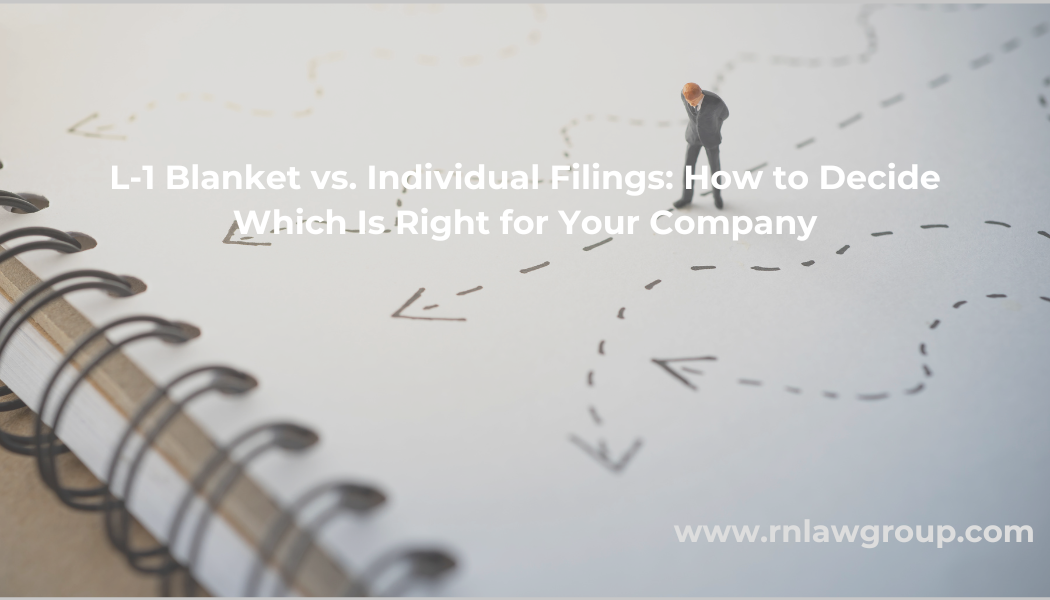
L-1 Blanket vs. Individual Filings: How to Decide Which Is Right for Your Company
The L-1 intracompany transferee visa allows a multinational company to transfer certain qualified employees from its foreign offices to a related U.S. branch, subsidiary, or affiliate. To qualify, the company must have a qualifying relationship between the U.S. and foreign entities, typically through common ownership or control of at least 50 percent, and must be actively doing business in both the United States and at least one other country. In addition, the employee must have worked for a qualifying foreign entity for at least one continuous year within the past three years and be coming to the United States to serve in a managerial, executive, or specialized knowledge capacity.
Employers can pursue these transfers in two ways: by filing an individual L-1 petition for each employee or by obtaining an L-1 blanket approval, which pre-establishes the qualifying corporate structure with USCIS. While both routes ultimately lead to the same L-1 classification, they differ in eligibility, process, and strategic application.
Individual L-1 Petitions
An individual L-1 petition is filed for a single employee with U.S. Citizenship and Immigration Services (USCIS). This option is typically used by smaller organizations or first-time L-1 employers. Each petition must independently show that a qualifying relationship exists between the U.S. and foreign entity, that the employee worked abroad for at least one continuous year within the last three years for that foreign entity, and that the foreign and U.S. position are in a managerial, executive, or specialized-knowledge capacity.
USCIS adjudicates each petition directly, and employers may request premium processing for faster results. If the employee is outside the United States, they must still attend a visa interview at a U.S. embassy or consulate after the petition is approved to gain entry to the U.S. If the employee is already in the United States and the petition is approved with a valid I-94, that approval alone authorizes them to begin or continue working in L-1 status without separate visa stamping.
L-1 Blanket Petitions
An L-1 blanket petition allows a large multinational group to pre-qualify its corporate structure with USCIS. Filing a blanket L-1 effectively splits the L-1 process, where the company first obtains blanket approval confirming that all US and foreign entities meet the qualifying relationship requirements, and then each employee applies individually under that umbrella. By doing this, the company avoids having to re-document the same ownership and control evidence for every employee they want to sponsor for the L-1. After the blanket petition is approved, eligible employees can apply for their L-1 visas more quickly, typically by submitting their applications directly at a U.S. consulate abroad without waiting for separate USCIS adjudication. However, there are additional requirements to file a blanket L-1 petition. To qualify, the company must:
- Have at least three related entities (U.S. and foreign).
- Have been doing business in the United States for at least one year.
- Meet one of three volume or size thresholds, such as:
- Ten or more L-1 approvals in the past year.
- Combined U.S. sales of at least $25 million.
- S. workforce of 1,000 or more employees.
A blanket petition is valid for an initial three-year period and may be extended indefinitely if the company continues to meet USCIS requirements. Employers must report significant organizational changes, but otherwise can rely on the approval to sponsor any number of qualified employees under the same framework. For companies that move personnel across borders frequently, the blanket process offers predictability, speed, and efficiency that individual petitions cannot match.
Comparing the Two Approaches
Both petition types follow the same basic eligibility standards for L-1 classification, but differ in their procedures and practical impact for employers.
- Speed and Process: Individual petitions require full USCIS review for each employee, whereas blanket cases, once the initial blanket is approved, allow faster processing through consulates.
- Eligibility Thresholds: Any company with a qualifying foreign entity can file individually; blanket filings are generally limited to larger multinational organizations.
- Cost: Individual petitions incur standard filing fees each time. Blankets have higher initial preparation costs but lower marginal costs per transfer.
Choosing between an individual and blanket L-1 petition depends on the company’s size, transfer volume, and organizational stability. An individual petition may be more appropriate for newer or smaller organizations, when only a few transfers are anticipated each year, or when each case requires customized documentation. A blanket petition may be preferable for employers with frequent transfers, established corporate relationships, and a need to avoid repetitive USCIS filings.
Both the individual and blanket L-1 processes enable multinational companies to transfer key personnel to the United States. The right choice depends on your organization’s structure, growth plans, and expected transfer activity. By evaluating eligibility and long-term mobility needs in advance, companies can determine which approach best supports their overall global mobility strategy.
By: Adena Bowman
Adena Bowman is a Senior Associate Attorney at Reddy Neumann Brown PC with over 12 years of experience in U.S. immigration law. She helps clients ranging from small businesses to large multinational corporations bring workers to the U.S. and stay compliant with immigration regulations. She also guides individual clients through employment, investment, and family-based immigration matters. Clients rely on her for clear guidance, strategic planning, and personalized support in navigating complex immigration challenges.

